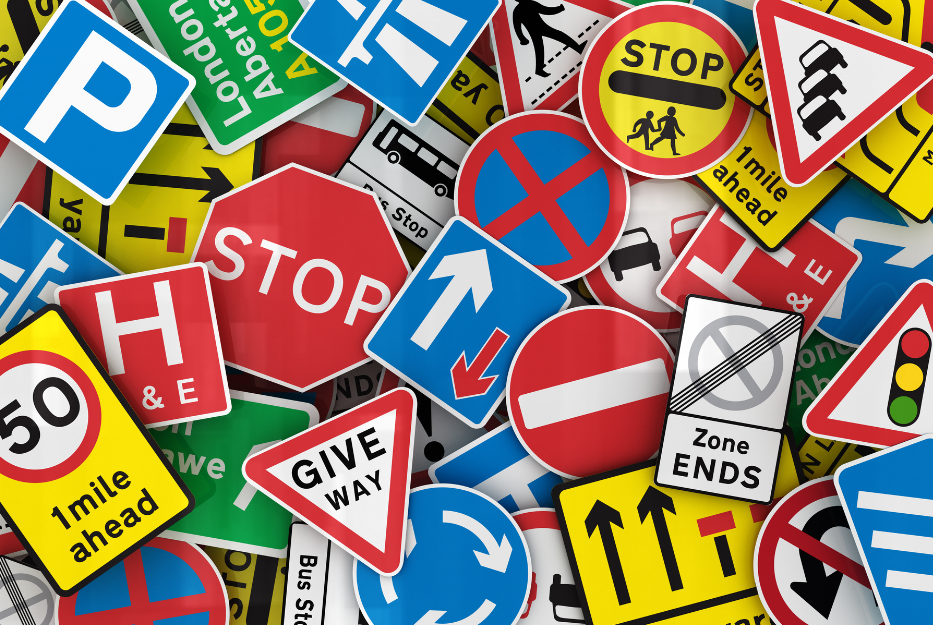**Please review the disclaimer at the end of this document before reading or using this guide.
Navigating the roads in a new country can be challenging, but understanding traffic laws is crucial for safety and compliance. Canada has specific traffic regulations to ensure the orderly and safe flow of vehicles and pedestrians. This guide provides information on Canadian traffic laws, including pictures of common traffic signs and signals.
Driving Licenses
- Obtaining a Driver’s License:
- Provincial Jurisdiction: Driving licenses are issued by provincial and territorial governments. Requirements vary, so check your local licensing authority.
- GDL System: Many provinces use a Graduated Driver Licensing (GDL) system, which includes stages like learner’s permit, intermediate, and full license.
- Exchange Programs: Some provinces allow new residents to exchange their foreign license for a Canadian one, depending on reciprocal agreements.
- International Driving Permits (IDP):
- Valid for a limited time (usually 60-90 days) while you obtain a local license.
Basic Traffic Rules
- Driving on the Right:
- In Canada, vehicles drive on the right side of the road.
- Speed Limits:
- Urban Areas: Typically 50 km/h (31 mph).
- Rural Areas: Typically 80 km/h (50 mph).
- Highways: Between 90 km/h (56 mph) and 120 km/h (75 mph), depending on the province.
- Traffic Signals:
- Red Light: Stop completely. Right turns on red are generally allowed after a full stop, unless otherwise posted.
- Yellow Light: Prepare to stop; it indicates the light will soon turn red.
- Green Light: Proceed if the way is clear.
- Flashing Red: Treat it as a stop sign.
- Flashing Yellow: Proceed with caution.
- Stop Signs:
- Stop completely, check for traffic, and proceed when safe. In some areas, a stop sign may be accompanied by a white line indicating where to stop.
Specific Road Rules
- School Zones:
- Reduced speed limits (30-40 km/h) during school hours.
- Be extra cautious for children crossing.
- Pedestrian Crosswalks:
- Yield to pedestrians at crosswalks and intersections.
- In some provinces, flashing lights indicate pedestrian crossings.
- Roundabouts:
- Yield to traffic already in the roundabout.
- Use your signal when exiting.
- Bicycle Lanes:
- Do not drive or park in designated bicycle lanes.
- Distracted Driving:
- Using handheld devices while driving is illegal and subject to fines.
Seat Belts and Child Safety
- Seat Belts:
- Mandatory for all passengers.
- The driver is responsible for ensuring all passengers are buckled up.
- Child Car Seats:
- Children must be secured in appropriate car seats or booster seats based on their age, weight, and height.
- Follow provincial guidelines for specific requirements.
Drinking and Driving
- Blood Alcohol Concentration (BAC) Limits:
- The legal BAC limit is generally 0.08%, but many provinces have lower limits for new and young drivers (e.g., 0.05%).
- Zero tolerance policies may apply for novice drivers.
- Penalties:
- Fines, license suspension, vehicle impoundment, and potential jail time.
Insurance and Registration
- Vehicle Insurance:
- Mandatory to have vehicle insurance. Minimum coverage varies by province.
- Proof of insurance must be carried in the vehicle at all times.
- Vehicle Registration:
- All vehicles must be registered with the provincial or territorial authority.
- License plates must be displayed on the front and rear of the vehicle (varies by province).
Emergency Procedures
- Accidents:
- Stop immediately, check for injuries, and call emergency services (911).
- Exchange information with the other driver and report the accident to the police if necessary.
- Breakdowns:
- Move the vehicle to the side of the road if possible.
- Use hazard lights and emergency triangles to alert other drivers.
Road Signs and Markings
1. Regulatory Signs:
- Indicate laws and regulations (e.g., speed limits, stop signs).
2. Warning Signs:
- Alert drivers to potential hazards (e.g., sharp turns, pedestrian crossings).
3. Informational Signs:
- Provide information on routes, distances, and points of interest.
Understanding and following Canadian traffic laws is essential for safe driving and avoiding fines or penalties. By familiarizing yourself with the rules, obtaining the necessary licenses and insurance, and practicing safe driving habits, you can ensure a smooth and lawful driving experience in Canada. Welcome to Canada, and drive safely!
**DISCLAIMER: This document was prepared based on information gathered from various online sources. While our aim is to provide accurate and helpful information to newcomers in Canada, Active Action cannot be held responsible for any actions, outcomes, or situations that may arise from the use of this document. We strongly recommend that you verify any details with official sources or relevant authorities if you have any doubts or uncertainties about any information provided in this document. If you have any specific questions about the information in this document, or if you notice any inaccuracies or missing information, please inform us immediately through the contact form. We will respond to you as soon as possible and/or update the information as necessary.



